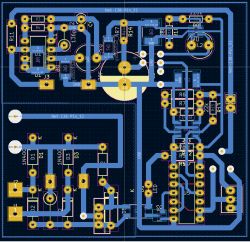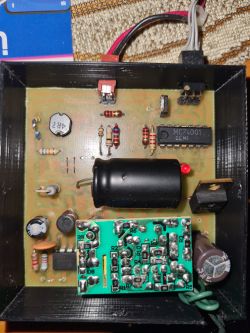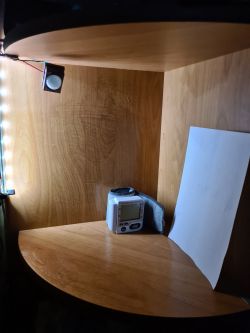Economical night-time lighting, not only for seniors
The project I present below shows LED lighting ( but can also be classic ) switched on by a PIR sensor.
In my case, the inspiration was the notorious spilling of a sweet drink when I reached for it at night.
You're sleepy, it's a dark night, you want a drink, but it's hard to hit the glass in the dark, so it happened that all or part of the contents of the glass landed on the carpet instead of giving the thirsty person a drink.
Then, of course, the cleaning of such stains is both cumbersome and laborious.
The system presented here can also be used to light the way to the fountain or any other way to be travelled at night or in the dark (e.g. the cellar).
I should add that the device is very energy-efficient, as the power supply is switched on only briefly to maintain voltage on the supercapacitor and, of course, when lighting is activated via the PIR. For 99% of the time, the system draws practically no energy from the 230V mains.
To begin with, of course, the schematic diagram:
 .
.
and the circuit board, as usual made by myself:
 .
.
It's worth saying a few words about the electronics themselves.
I don't have a problem with using processors where it makes sense, but in this case I preferred to use "more discrete" circuits, as using a processor in such a circuit wouldn't simplify anything circuit-wise, and you'd have to write some nonsense control software in addition.
So how does the circuit work?
Let's start with the fact that the circuit remains in standby for 100% of the time while being powered by the supercapacitor. When the voltage on the supercapacitor is sufficient, the circuit blocks the mains voltage through a circuit consisting of an optocoupler, an NMOS transistor and a bridge rectifier.
When the voltage on the supercapacitor drops below a designated level, the mains voltage is switched on and goes to a DC/DC converter or, more precisely, an AC/DC converter working as a DC/DC in this circuit. The inverter is an ordinary power supply from some mobile charger giving 12V and about 400mA at its output.
This voltage is used to power our LED strip and, when reduced to a value of about 2.7, charges our supercapacitor.
When the voltage on the supercapacitor reaches the required value, the mains voltage is disconnected from the circuit. The charging time of the supercapacitor is two to three minutes, and then the system operates for about six hours on the supercapacitor alone.
When movement activates the PIR detector, the mains voltage is switched on to power the lighting connected via the NMOS transistor, while the supercapacitor is charged.
Sensitivity and duration of illumination are adjusted by Pr-controls in the PIR detector (obviously of Chinese manufacture).
The mains voltage switching circuit is made on LM393 comparators and a CD4001 chip.
It is strikingly similar to the NE555 circuit, which gave me the idea to replace the LM393 and CD4001 tandem with some NE555 type circuit.
Unfortunately, the standard NE555 has improperly set switching thresholds and also draws considerable current, which is undesirable in such a device.
So I found Texas TLC555 circuits in my stash and reworked the circuit diagram for these. They have negligible resting current, small dimensions (SMD) and replace (after minor modification) a pair of LM393 and CD4001, saving space and standby current consumption.
Below is a diagram of the device with the TLC555 chip:
 .
.
The finished circuit in the box looks like this:
 .
.
And then there's the same arrangement mounted on a bedside cabinet:
 .
.
I hope the layout is useful to someone and saves someone's carpet
I encourage esteemed colleagues to enrich the topic with their thoughts and/or ideas.
In my case, the inspiration was the notorious spilling of a sweet drink when I reached for it at night.
You're sleepy, it's a dark night, you want a drink, but it's hard to hit the glass in the dark, so it happened that all or part of the contents of the glass landed on the carpet instead of giving the thirsty person a drink.
Then, of course, the cleaning of such stains is both cumbersome and laborious.
The system presented here can also be used to light the way to the fountain or any other way to be travelled at night or in the dark (e.g. the cellar).
I should add that the device is very energy-efficient, as the power supply is switched on only briefly to maintain voltage on the supercapacitor and, of course, when lighting is activated via the PIR. For 99% of the time, the system draws practically no energy from the 230V mains.
To begin with, of course, the schematic diagram:
 .
.
and the circuit board, as usual made by myself:
 .
.
It's worth saying a few words about the electronics themselves.
I don't have a problem with using processors where it makes sense, but in this case I preferred to use "more discrete" circuits, as using a processor in such a circuit wouldn't simplify anything circuit-wise, and you'd have to write some nonsense control software in addition.
So how does the circuit work?
Let's start with the fact that the circuit remains in standby for 100% of the time while being powered by the supercapacitor. When the voltage on the supercapacitor is sufficient, the circuit blocks the mains voltage through a circuit consisting of an optocoupler, an NMOS transistor and a bridge rectifier.
When the voltage on the supercapacitor drops below a designated level, the mains voltage is switched on and goes to a DC/DC converter or, more precisely, an AC/DC converter working as a DC/DC in this circuit. The inverter is an ordinary power supply from some mobile charger giving 12V and about 400mA at its output.
This voltage is used to power our LED strip and, when reduced to a value of about 2.7, charges our supercapacitor.
When the voltage on the supercapacitor reaches the required value, the mains voltage is disconnected from the circuit. The charging time of the supercapacitor is two to three minutes, and then the system operates for about six hours on the supercapacitor alone.
When movement activates the PIR detector, the mains voltage is switched on to power the lighting connected via the NMOS transistor, while the supercapacitor is charged.
Sensitivity and duration of illumination are adjusted by Pr-controls in the PIR detector (obviously of Chinese manufacture).
The mains voltage switching circuit is made on LM393 comparators and a CD4001 chip.
It is strikingly similar to the NE555 circuit, which gave me the idea to replace the LM393 and CD4001 tandem with some NE555 type circuit.
Unfortunately, the standard NE555 has improperly set switching thresholds and also draws considerable current, which is undesirable in such a device.
So I found Texas TLC555 circuits in my stash and reworked the circuit diagram for these. They have negligible resting current, small dimensions (SMD) and replace (after minor modification) a pair of LM393 and CD4001, saving space and standby current consumption.
Below is a diagram of the device with the TLC555 chip:
 .
.
The finished circuit in the box looks like this:
 .
.
And then there's the same arrangement mounted on a bedside cabinet:
 .
.
I hope the layout is useful to someone and saves someone's carpet
I encourage esteemed colleagues to enrich the topic with their thoughts and/or ideas.
Moderated By Felini:.3.1.13. Publish posts that violate the spelling rules of the Polish language, are careless and incomprehensible.
The word "supercapacitor" does not exist in the Polish language.



Comments
It's nice to look at the analogue logic and your work put into it, but additionally with me you would have won the monthly form over content contest ;) . You don't write specifically what the current... [Read more]
Plus for the independent construction. I see some drawbacks here. Firstly, the circuit does not have a light sensor and will also switch on during the day. I also don't quite understand what the point... [Read more]
Such lights at a price of £11 I think are still on ali of course with a brightness sensor, the only problem is during the day you have to expose them to the sun. [Read more]
. It doesn't work like that, energy is time times power and it doesn't matter to the meter whether you switch the power supply on briefly or leave it in "contact" permanently. Someone calculated that... [Read more]
I see no problem with using another term instead of 'supercapacitor', although it has been in use in my circles for many years. To those offended I apologise :) . However, going back to the comments... [Read more]
Is this how you can do it without a microcontroller? :) Joke! Great! The good old days of electrodes are back! Write me a packet and I'll send a small gift. [Read more]
I like it. Wouldn't it be a problem to publish the KiCad files? [Read more]
Yes, it is not a problem at all. The only question is whether you want the version with LM393 and CD4001 or the one on TLC555? [Read more]
If I have to choose, it's with the LM 393, but preferably both versions, just in case. [Read more]
An idea that is impractical in every way. The motion sensor will react to any movement of the sleeping person and the light may be on all night. Ready-made devices of this type can be bought, not as written... [Read more]
both versions on request :) [Read more]
@md I didn't write that there aren't any, but they all either have an on/off switch, are battery operated, are expensive, don't give room for your own creativity, and are certainly Chinese made which... [Read more]
. How did you measure this? Specify: - what charger it is, what power it has, - with what instrument you made the power measurement, - under what conditions you made the measurement. [Read more]
I have three more comments on the design of the device. The output voltage of the 34063 regulator should be set so that the voltage on the cathode of diode D7 does not exceed the maximum permissible... [Read more]
That's what I don't understand... [Read more]
Is it the grid that switches off at night like in Zanzibar that you need an emergency power supply? Because supercapacitors are used for such purposes (if only to maintain the memory of some programmed... [Read more]
1. Emergency power supply: . Supercapacitors are often used to maintain memory or clock walk in the event of short power interruptions. They have the ability to charge and discharge quickly, making... [Read more]
Unfortunately, this illumination will then be switched on if that glass of drink is knocked over. It is important that the illumination occurs even before the intention to reach for the glass, even if... [Read more]
PIR sensors have a considerable tripping delay. The question is whether the movement of a hand reaching for a glass can switch on the lighting in time? I once built a circuit to switch on the lighting... [Read more]